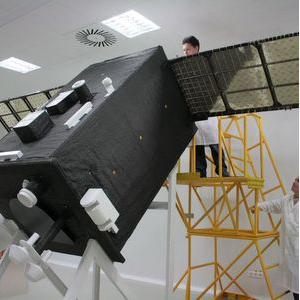
English > News
Samara University scientists have developed a new technology to create solar batteries
18.02.2016, 12:45
Samara University scientists have developed a technology of new-designed photoelectric converters for solar batteries of spacecraft. It is based on the use of well-known semiconducting materials - silicon and silicon carbide. The new solar batteries will be as much effective as their contemporary nanoheterostructured counterparts surface-supported by germanium, and the cost will be five times cheaper.
Since 1958 solar batteries are one of the most important parts of spacecraft. They convert sunlight energy into electric current, which powers all of their mechanisms. Initially, silicon was the basis of space photoconverters. However, currently multi-layered planar nanostructure surface-supported by germanium is used in the production of many solar batteries for satellites.
Scientists of Samara University (joint SSAU and SSU) developed a technology basis of new silicon-based photoelectric converters (FEC). According to laboratory tests its efficiency factor can reach 30% or higher. Such parameters have the most effective to date nanoheterostructured photoelectric converters based on АIIIBV compounds.
However, much more complicated, expensive and dangerous technology is used in the production of these photoelectric converters (it is associated with toxic arsenic and phosphorus compounds) and gradually dwindling sources of raw materials of rare-earth metals (gallium, indium, germanium).
The new technology relevance is also linked to the fact that according to the US Geological Survey 9/10 of germanium in the world is situated outside Russia - in the US and China.
In addition, nanoheterostruktured photoelectric converters based on АIIIBV compounds are heavier than silicon-based - its specific gravity is up to 1.9 kg / m2 compared to 1.7 kg / m2 of the silicon-based, which is very important for use in space, where each kilogram is literally “is worth its weight in gold”.
The basis of effective silicon-based photoelectric converters, created by the scientists of Samara University, is a multi-layer structure comprising layers of silicon and silicon carbide nanocrystals, as well as special coating with ions of rare earth elements. Each layer “works” on its part of the solar spectrum, increasing the proportion of the absorbed energy in this section, so that in whole it results in notable increase of conversion efficiency. Manufacturing technology of this structure is based on well-established production technology of silicon devices. The used materials (silicon, carbon, silicon carbide) have low toxicity and the sources of raw material for their production are practically unlimited.
The new Russian design of photoelectric converters based on porous nanocrystalline silicon makes it possible to get solar cells as effective as photoelectric converters based on АIIIBV compounds. However it will cost at least 5 times cheaper (a silicon substrate is 5 times cheaper than a germanium substrate), than those currently used by Russian companies-producers of spacecraft. And above all, working capacity of Russian satellites will not depend on the presence or absence of germanium in Russia.
“Our technology is much simpler and more effective than its foreign counterparts and can be used for the production of photoelectric converters not only for space solar batteries. We use the latest achievements of nanotechnology and available inexpensive materials, and it has already delivered good results. We have obtained prototypes of a new type of photoelectric converters, using the power of one of the Russian enterprises”, - underline Natalya Latukhina, Assistant Professor of SSAU Department of Radiophysics and Semiconductor Microelectronics and Nanoelectronics.
In the spring of this year, development prototypes of photoelectric converters made by the scientists of Samara University will be tested in outer space on-board of the spacecraft “Aist-2”, which will be launched from the new Russian space launcher complex “Vostochniy” as a part of the first launch campaign.
On-board of the satellite were installed 13 panels of various types 2x3 cm in size with a porous layer and one control sample without a porous layer with silicon nanocrystals. Telemetry data from each plate to be received in the Rocket and Space Centre “Progress”, will allow the scientists of Samara University and the specialists of the Rocket and Space Centre to select the sample type which is more resistant to space radiation.
In the future, subject to successful completion of the flight tests and introduction of this technology into mass production, the new Russian solar silicon batteries can be installed not only on satellites but also on unpiloted aircrafts, electric motor cars, charging units for mobile phones, smartphones, computers, as well as any on-board electronics, etc.









